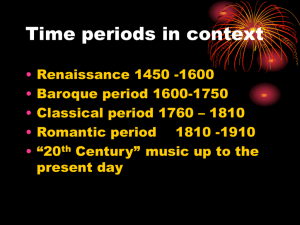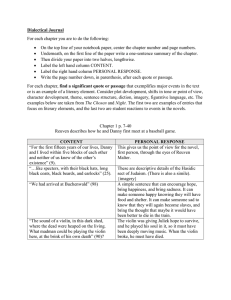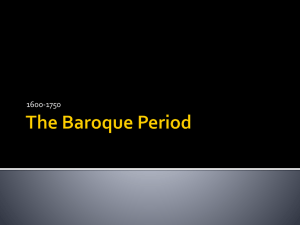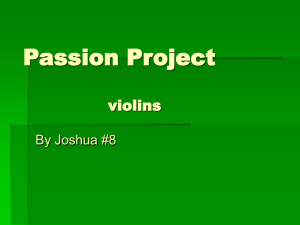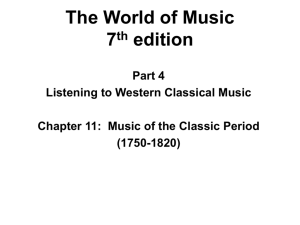Document 11213051
advertisement
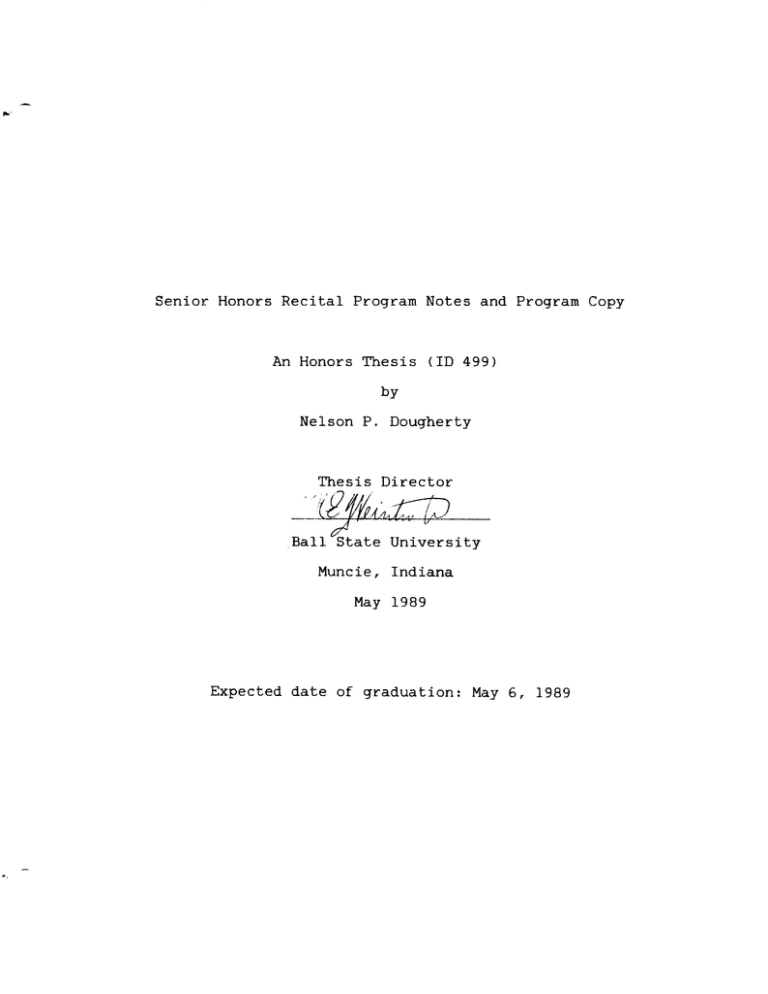
.... Senior Honors Recital Program Notes and Program Copy An Honors Thesis (ID 499) by Nelson P. Dougherty Thesis Director . /i (71ft' .t:::J;J ,-C A.a'loA c:4 Ball State University Muncie, Indiana May 1989 Expected date of graduation: May 6, 1989 5rJ t.o f i ihe'SI':" LC; ;J.U Mf S'; :ZLf I q 2<r ~ r ,: !.. ./ C \.r'l 1,.-- April 28, 1989 Pruis Hall 8:00 PM Nelson Dougherty, violin and Caroline Sullivan, piano in a Senior Honors/Master of Music Recital Sonata for Piano and Violin in B flat, K.454 Largo--Allegro (--8min.--) Andante (--7min.--) Allegretto (--7min.--) Beau Soir Wolfgang Amadeus Mozart (1756-1791) Claude Debussy (1862-1918) Trans. Jascha Heifetz (1901-1988) (--4min.--) Rumanian Folk Dances (--7min.--) I Joe Cu Bata II Braul III Pe Loc IV Buciumeana V Poarga Romaneasca VI Maruntel Bela Bartok (1881-1945) Trans. Zoltan Szekely (b.1903) -IntermissionJohannes Brahms (1833-1897) Sonata for Piano and Violin in A, Op.lOO (--8min.--) Alleg'ro amabile (--6min.--) Andante tranquillo--Vivace (--7min.--) AllegTetto grazioso (quasi Andante) Nelson Dougherty is a student of Neil Weintrob and a member of Pi Kappa Lambda, national music honor society, and Mu Phi Epsilon, international professional fraternity in the field of music. This recital is presented in partial fulfillment of the requirements for the Bachelor of Music degree and the Honors program at Ball State. Caroline Sullivan is a student of Mitchell Andrews and a member of Pi Kappa Lambda, national music honor society, Mu Phi Epsilon, international professional fraternity in the field of music, and the Indiana Federated Music Clubs. This recital is presented in partial fulfillment of the requirements for the degree Master of Music with an emphasis in Chamber Music/Accompanying. Dedicated to Clay Edwards (1967-1989). PROGRAM NOTES Nelson P. Dougherty, Violin SENIOR HONORS RECITAL Pruis Hall - Friday, April 28, 1989 - 8:00 P.M. Mozart Sonata for Piano and Violin in B~ Major, K.454 The piano/violin sonata is a form which Mozart used throughout much of his life. In fact, this form comprises many of his earliest works, i.e. K.6-l5(Op.1-3). Mozart was a gifted violinist as well as being a virtuoso keyboard player, and was thus very familiar witrl both instruments. The piano/violin sonatas display a wide range of styles and demonstrate well Mozart's growth as a musician. The earliest examples are written primarily for the keyboard with an accompanying violin, which played mainly arppegiated chords or doublings of the melody. The title pages of the early wm~ks even describe the pieces as "Sonatas for the Clavier which can be played with the Accompaniment of the Violin." Mozart's compositions in this form show gradual increases in both the difficulty of the individual parts and the importance of the violin part. The sonatas written in 1778, K.30l-306, were described by Mozart as "Keyboard duets with Violin," and become progressively more difficult in bothbparts despite their usual two-movement format. The Sonata in B Major, K.454 could be seen as the culmination of Mozart's wriLi.ng in the piano/violin sonata form. Although not his last piece in this form, the "Big B flat", so named due to its length, difficulty, and importance, is perhaps the most virtuosic and the most equal in importance of the two instrumental parts. The sonata begins with a stately Largo introduction,. which George de Saint-Foix and Theodore de Wyzewa describe as the contrast of the masculine to the feminine. The Allegro which follows makes use of a far greater range of dynamics than the earlier piano/violin sonatas and also makes use of the violin in as high as the fifth position, a very rare occurrence in the earlier sonatas. The Andante makes use of a new ornamentation with almost every recurrence of a theme and forms a complex weave as the two parts exchange the melody, sometimes as often as at each new measure. Carl Earl Forsberg has described this movement as, "one of the outstanding movements in the literature for the two instruments." The Allegretto in rondo form makes use again of an incrediblE~ range of dynamics, often different with each repeti~ion, and ends the piece with a display of virtuosity. The "Big B " was hastily written by Mozart to be played in a concert, April 29, 17El4, with the famed Italian woman violinist, Regina Strinasacchi (1764-1839), and has become a testament to Mozart's ability to compose in his head. Having only time to write out the violin part, Mozart performed the piano part from his head/memory without a rehearsal. This sonata remains one of the most performed of the Mozart Piano/Violin Sonatas. Incidentally, in 1822, Regina Strinassacchi sold the same Stradivari violin to the famed Louis Spohr (1785-1859) that had been used in the historic first performance with Mozart. Debussy, Beau Soir Beau Soir is one of 56 songs (melodies) written by Debussy explicitly for voice and piano. These works are generally of a very high caliber despite Debussy's own negative feelings toward them. Many survived in private collections, having been sold by Debussy in times of need. Debussy was quite a well read person, and these pieces were usually written using the text of only the most respected of writers. Debussy was more at ease in the company of writers ttlan he was around musicians and developed strong views as to how a composer needed to deal with setting text to music. In a reply to a questionnaire on the connection between music and poetry Debussy stated, "Musicians who understand nothing about poetry ought not set it to music ... Schumann never understood Heine ... he was incapable of understanding all of Heinrich Heine's subtle irony ... Real poetry has its own rhythms. It is very difficult to follow closely or to "impose" rhythms, while maintaining the inspiration. Classical verse has a life of its own ... Rhythmic prose is easier to set-one has more freedom in every direction." The text to vlhich Beau Soir was written demonstrates these qualities well. It has a very subtle approach and makes use of much rhythmic freedom. The original poetry was written by the famous poet and writer and friend of Debussy's, Paul Bourget. Debussy set 10 of Bourget's texts and Beau Soir was the first of these. Although this work is only the second published art song by Debussy, it betrays a composer who is already a master at text setting. The music creates the appearance of the natural rhythm of the spoken French without taking the form of a recitative. The translation of the text is as follows: When in the sunset the streams are red, And a warm breeze blows on the wheat fields, Advice to be happy seems to flow from things And to rise towards the troubled heart. Advice to enjoy the charm of being in the world While one is young and the evening is beautiful, For we go like that wave, It to the sea, we to the grave. Of the many musical interests of Jascha Heifetz one of the greatest was the expansion of the violin repertoire to include transcriptions of standard pieces from other areas of music to be used in solo recitals as "crowd pleasers" or encore pieces. Some of the more than 75 transcriptions which Heifetz made have now become standards in the violin repertoire, including: J.S.Bach Air from Suite No.3, Castelnuovo--Tedesco Tango, Chopin Nocturne, Op.55,No.2, Debussy L,Apres-midi d'un faune, Foster Jeanie with the Light Brown Hair, Saint-Saens The Swan, and five pieces from Gershwin's Porgy and Bess. Heifetz's transcription of Beau Soir makes changes in rhythm and in some places the violin part varies greatly from the vocal part but the original is never lost and is done no injustice. Bartok, Rumanian Folk Dances Bartok, an Hungarian composer/performer known as much for his ethnomusicology as his composition or performance, made much use of Eastern European, especially Hungarian and Rumanian, folk music in his compositions. In his music for solo piano 189 (48%) of the 393 individual movements make use of authentic folk tunes, dances, or songs. The Rumanian Folk Dances, originally written in 1915 for piano solo, are from this gendre with extra harmony and texture added by Bartok. Originally titled Rumanian Folk Dances from Hungary, the set of dances were renamed by Bartok after Transylvania, previously a Hungarian territory, was annexed to Rumania in 1920. Bartok dedicated this piece to his Rumanian friend, Ion Busitia, who was instrumental in assisting Bartok with his folk music collecting tours throughout Transylvania. The six dances include seven melodies which were originally played on violin or thE~ shepherd's flute. The first dance, Joe cu Bata (Dance with Sticks), is according to Bartok, "a young men's solo dance, with various figures the last of which --as a consummation---consists of kicking the room's ceiling!" The music was originally played with one violin playing the melody and another (a trlree-stringed variety) playing chords on the strong beats. The music for the second dance, Braul (Waistband Dance), was played on flute in its authentic form, and the dance itself was,"performed at gatherings in the spinning house, generally only by girls, sometimes by young men and girls. They hold each other, their arms tightly clasped around each other's [waists], and form a circle ... " The third dance, Pe Loc (On the Spot) is one in which the dancers do not move from their location, and the limited range of the melody helps to describe this. This dance was performed on a solo flute and the violin/piano transcription uses artificial harmonics on the violin to represent the correct timbre. The fourth dance,. Buciumeana (Butschum [Transylvania]), was originally a violin solo with bass-chord accompaniment. The Poarga Romaneasca (Rumanian Polka), is a children's dance, and the final dance, Maruntel (Fast Dance), is a couples dance which requires much stamina and the ability to coordinate many unusual rhythms. This last dance was also originally for violin solo. It seems only natural that a set of pieces mostly written to played on the violin would be re-transcribed for the violin, this time with piano accompaniment. The transcriber, Zoltan Szekely, was an Hungarian violinist and composer who had studied with Hubay and Kodaly in Budapest. Szekely was a frequent recital partner of Bartok and Bartok dedicated his Violin Concerto as well as his 2nd Rhapsody to rlim. The Rumanian Folk Dances have been transcribed for small orchestra twice, once by Bartok himself, and have also been transcribed for string orchestra, violoncello and piano, and of course violin and piano. Brahms, Sonata for Piano and Violin in A Major Brahms wrote three sonatas for piano and violin of which this is the middle. It was written in a time of relative ease and peace in Brahms' life and is one of the most carefree works written by him. In terms of the three violin sonatas, the A Major has been referred to as "the blonde." It carries neither the profundity of the G Major ~;onata (the brunette?) nor the fire and flash of the D Minor Sonata (the red-head?). It was written in 1886 while Brahms was living in Thun, Switzerland near his friend Widmann, and it is consequently sometimes called the "Thun Sonata." The first performance was held at WidIlluLlii' ~ house in Berne, and Widmann wrote a fairy ballad about the sonata. Brahms enjoyed the ballad enough that he often wrote Widmann with a request for additional copies. As in all of Brahms' chamber music with piano, the piano has at least an even role if not a superior one to the other instrument. Brahms was noted as being an incredibly facile pianist, especially when playing his own music. Brahms frequently performed with violinists for recitals, even early in his training, and his long-time friends Joseph Joachim and Clara Schumann WerE! frequently providing oportunities to hear or perform the violin sonatas. The A Major Sonata is also sometimes called the "Meistersinger" Sonata due to a highly contrived connection concocted between the first three notes of the sonata and Walter's Prize Song from the Meistersinger. This connection was used to attempt to dj.scredit Brahms but had little effect. The second movement of this sonata deserves a special note. It has the form of a hybrid Eiecond and third movement. It retains both the feel of a slow second movement and a scherzo movement by use of alternation between the two styles. The sonata is marked by a true welding of the two voices into one larger unit and remains a staple in the repertoires of both instruments.

